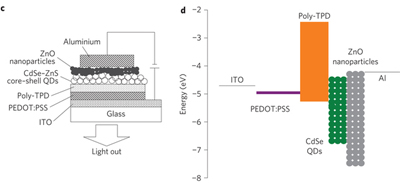
Recently, Qian et. al. demonstrated a solution-based process to fabricate QD-LEDs by utilizing crystalline zinc oxide (ZnO) nanoparticles as the electron transport layer within the multilayer diode structure. By combining this with a thermally polymerizable hole conducting polymer, a complete solution based synthesis approach has been reported for realizing QD-LED devices. Additionally, the excellent electron charge injection and transport properties, combined with the favorable heterojunction bandgap structure provided by the ZnO nanoparticle layer, have exhibited significant improvement in QD-LED efficiency and luminance properties. In fabricating the multilayer diode structure, the authors first began with a transparent indium-tin oxide (ITO) electrode layer on a glass substrate. Subsequent solution layers materials were deposited by spin-coating to achieve specific thickness targets consisting of poly(ethylenedioxythiophene):polystyrene sulphonate (PEDOT:PSS) (40 nm), poly(N,N’-bis(4-butylphenyl)-N,N’-bis(phenyl)benzidine) (poly-TPD) (45 nm), cadmium selenide-zinc sulfide (CdSe-ZnS) core shell QDs (13-25 nm), and ZnO nanoparticles (25-75 nm). The final layer consisted of an aluminum electrode deposited by a vacuum coating process.
Characterization of the QD-LED devices demonstrated both high maximum luminance and power efficiencies in the blue, green, and red-orange spectral ranges. Typical drive voltages on the order of 4 Volts were needed to achieve 600 Cd/m-2 brightness. The efficient luminance was attributed to an enhanced Auger recombination up-conversion mechanism wherein the charge injected into the hole transport layer and QD emission layers are pinned at the heterojunction interface, thereby facilitating a charge buildup. The associated power efficiency additionally is impacted by the improved charge transport in both the poly-TPD hole conducting layer and the ZnO nanoparticle electron transport layer. Furthermore, with the incorporation of the ZnO nanoparticle layer, the QD-LED devices exhibit high environmental stability, having demonstrated operating lifetime in excess of 250 hr at 600 Cd/m-2 for unencapsulated devices. While additional optimization of luminance and power efficiency for the QD-LED devices will be necessary for specific applications, this work demonstrates a key milestone towards technical and economic viability for these devices. Further optimization of the solution-based synthesis via print or roll-to-roll manufacturing platforms now seems plausible for realizing next generation lighting and displays.
Reviewed by Jeff Morse, PhD, National Nanomanufacturing Network
- Qian L, Zheng Y, Xue J, Holloway PH. 2011. Stable and efficient quantum-dot light-emitting diodes based on solution-processed multilayer structures. Nature Photonics. 5: 543-548. http://dx.doi.org/10.1038/nphoton.2011.171
Figure reprinted by permission from Macmillan Publishers Ltd: Qian L, Zheng Y, Xue J, Holloway PH. 2011. Stable and efficient quantum-dot light-emitting diodes based on solution-processed multilayer structures. Nature Photonics. 5: 543-548. http://dx.doi.org/10.1038/nphoton.2011.171
